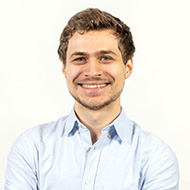Staff directory
- ORCID: 0000-0002-1437-8659
Publications
2024
-
Density functional Bogoliubov-de Gennes theory for superconductors implemented in the SIESTA code
Reho, R; Wittemeier, N; Kole, A H; Ordejon, P; Zanolli, Z Physical Review b; 110 (13): 134505. 2024. 10.1103/PhysRevB.110.134505. IF: 3.200
2023
-
Independent and coherent transitions between antiferromagnetic states of few-molecule systems
Besson, C; Stegmann, P; Schnee, M; Zanolli, Z; Achilli, S; Wittemeier, N; Vierck, A; Frielinghaus, R; Kögerler, P; Maultzsch, J; Ordejón, P; Schneider, CM; Hucht, A; König, J; Meyer, C Physical Review b; 107 (24): 245414. 2023. 10.1103/PhysRevB.107.245414. IF: 3.700
2022
-
Interference effects in one-dimensional moiré crystals
Wittemeier N., Verstraete M.J., Ordejón P., Zanolli Z. Carbon; 186: 416 - 422. 2022. 10.1016/j.carbon.2021.10.028. IF: 9.594
Interference effects in finite sections of one-dimensional moiré crystals are investigated using a Landauer-Büttiker formalism within the tight-binding approximation. We explain interlayer transport in double-wall carbon nanotubes and design a predictive model. Wave function interference is visible at the mesoscale: in the strong coupling regime, as a periodic modulation of quantum conductance and emergent localized states; in the localized-insulating regime, as a suppression of interlayer transport, and oscillations of the density of states. These results could be exploited to design quantum electronic devices. © 2021 The Authors
-
Manipulation of spin transport in graphene/transition metal dichalcogenide heterobilayers upon twisting
Pezo A., Zanolli Z., Wittemeier N., Ordejón P., Fazzio A., Roche S., Garcia J.H. 2D Materials; 9 (1, 015008) 2022. 10.1088/2053-1583/ac3378. IF: 7.103
Proximity effects between layered materials trigger a plethora of novel and exotic quantum transport phenomena. Besides, the capability to modulate the nature and strength of proximity effects by changing crystalline and interfacial symmetries offers a vast playground to optimize physical properties of relevance for innovative applications. In this work, we use large-scale first principles calculations to demonstrate that strain and twist-angle strongly vary the spin–orbit coupling (SOC) in graphene/transition metal dichalcogenide heterobilayers. Such a change results in a modulation of the spin relaxation times by up to two orders of magnitude. Additionally, the relative strengths of valley-Zeeman and Rashba SOC can be tailored upon twisting, which can turn the system into an ideal Dirac–Rashba regime or generate transitions between topological states of matter. These results shed new light on the debated variability of SOC and clarify how lattice deformations can be used as a knob to control spin transport. Our outcomes also suggest complex spin transport in polycrystalline materials, due to the random variation of grain orientation, which could reflect in large spatial fluctuations of SOC fields. © 2021 IOP Publishing Ltd
-
Tuning the topological band gap of bismuthene with silicon-based substrates
Wittemeier N., Ordejón P., Zanolli Z. JPhys Materials; 5 (3, 035002) 2022. 10.1088/2515-7639/ac84ad.
Some metastable polymorphs of bismuth monolayers (bismuthene) can host non-trivial topological phases. However, it remains unclear whether these polymorphs can become stable through interaction with a substrate, whether their topological properties are preserved, and how to design an optimal substrate to make the topological phase more robust. Using first-principles techniques, we demonstrate that bismuthene polymorphs can become stable over silicon carbide (SiC), silicon (Si), and silicon dioxide (SiO2) and that proximity interaction in these heterostructures has a significant effect on the electronic structure of the monolayer, even when bonding is weak. We show that van der Waals interactions and the breaking of the sublattice symmetry are the main factors driving changes in the electronic structure in non-covalently binding heterostructures. Our work demonstrates that substrate interaction can strengthen the topological properties of bismuthene polymorphs and make them accessible for experimental investigations and technological applications. © 2022 The Author(s). Published by IOP Publishing Ltd.


